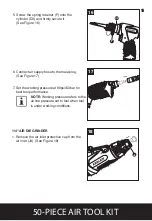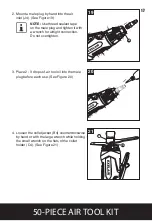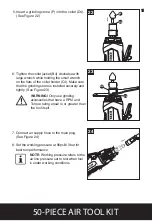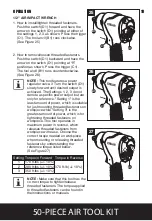
50-PIECE AIR TOOL KIT
Air ratchet wrench safety instructions
1. Always use the ratchet wrench in the manner and for the functions described in this
manual.
2. Always ensure the wrench is not moving and disconnected from the air supply
when changing sockets etc. Only use impact sockets. Do not use standard
sockets.
3. Always finish tightening threaded fasteners, bolts or nuts, or engine parts with a
calibrated torque wrench by hand to the correct torque as recommended by the
manufacturer where critical torque values are required.
4. Where critical torque values are not required, the final tightening of threaded
fasteners, bolts or nuts can be slightly tighter if gaskets are used between surfaces.
5. Use penetrating oil to assist in freeing off rusted fasteners, bolts and nuts if
necessary.
6. When assembling, first turn fasteners, bolts or nuts by hand onto workpiece. Then
start the tool for tightening.
7. Always ensure that the socket is correctly installed onto the tool anvil before
starting the tool.
8. Never carry the ratchet wrench by the air supply hose.
9. Always disconnect the tool from the air supply when changing sockets or when the
wrench is not required for immediate use in order to avoid accidental start.
10. Always ensure that the wrench has come to a complete stop before putting it
down after use.
11. If necessary, use clamps or proper devices to securely fix the workpiece when
installing/tightening or removing/loosening threaded fasteners on the workpiece.
12. For overhead work, wear a safety helmet.
13. Do not discard the safety instructions, give them to the operator.
14. Always store this product in a dry and safe place out of reach of children or
untrained operators.
Air hammer safety instructions
1. Always use the air hammer in the manner and for the functions described in this
manual.
2. Always ensure the tool is disconnected from the air supply when changing chisels.
3. Only use qualified chisels with sharp point or edge. Never use blunt chisels which
require excessive pressure and can break from fatigue.
4. Always ensure that the chisel is correctly installed onto the tool before starting the
tool.
5. Never contact the chisel during and after use as it can be hot and sharp. Wear
suitable gloves to protect hands.
6. If necessary, use clamps or proper devices to securely fix the workpiece.
7. Hold the tool firmly. Always use both hands to control the air hammer.
8. Make sure that there are no hidden electrical cables, gas pipes etc. inside or
around the workpiece to be free of a hazard if damaged by action of the chisels.
9. Never carry the tool by the air supply hose.
10. Always disconnect the tool from the air supply when the tool is not required for
immediate use in order to avoid accidental start.
11. Always ensure that the tool has come to a complete stop before putting it down
after use.
12. Do not discard the safety instructions, give them to the operator.
4






































